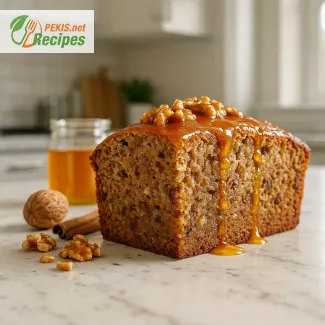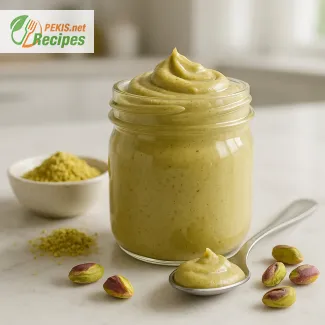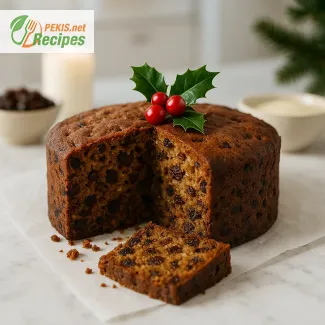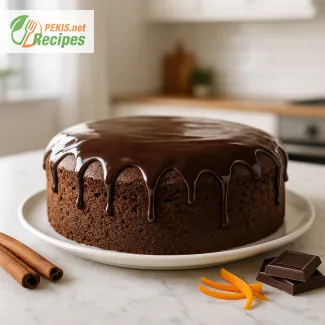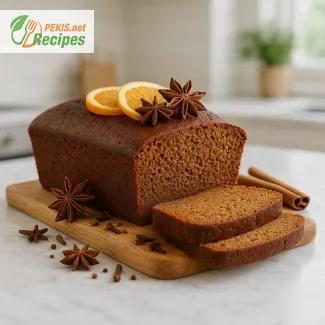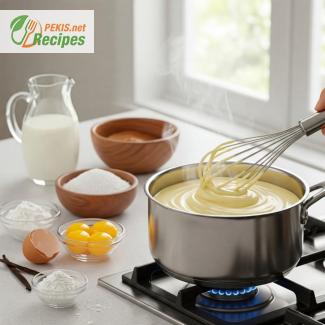
Irresistibly Creamy Vanilla Custard for Cakes
A luxurious layer to elevate any homemade cake
When it comes to creating a show-stopping dessert, the secret often lies in the filling. A moist sponge cake may be the canvas, but it’s the vanilla custard cream nestled between the layers that brings it to life. This classic vanilla cake filling is a celebration of smoothness, elegance, and pure flavor. Whether you're baking a festive birthday cake, a wedding masterpiece, or a simple Sunday treat, a silky vanilla filling adds that essential touch of indulgence.
At the heart of this recipe is the timeless appeal of vanilla—a flavor that evokes warmth, comfort, and nostalgia. But don't be fooled by its simplicity. When prepared properly, vanilla custard cream is anything but ordinary. It’s velvety, glossy, and luxurious, offering a perfect balance of sweetness and depth that complements a wide range of cake styles—from light chiffon to rich chocolate sponges.
This filling doesn’t just taste divine—it also offers structure. Its creamy consistency allows for easy spreading and layering, holding the cake together while enhancing its overall texture. It's the kind of component that makes your homemade cakes feel like they were crafted in a pâtisserie.
What makes this version stand out is its authentic, from-scratch preparation. There’s no shortcut here—only fresh ingredients, real vanilla, and time-honored culinary technique. The result is a silky custard that thickens beautifully, holds its shape when chilled, and doesn’t overwhelm the cake. It’s light enough to allow the sponge to shine, yet flavorful enough to leave a lasting impression with every bite.
Beyond its role in traditional layer cakes, this vanilla filling is incredibly versatile. It works wonderfully as a filling for cupcakes, cream puffs, and eclairs. Swirl it into trifles, serve it alongside fruit, or even use it as a base for your own creative dessert inventions. It's a kitchen staple for anyone who takes baking seriously.
One of the most rewarding aspects of making this filling from scratch is the control you have over the flavor profile. By using high-quality vanilla—whether from pods, paste, or extract—you can achieve a complex aroma that no artificial flavoring could match. Pair that with the richness of whole milk, the silkiness of egg yolks, and the slight sweetness of sugar, and you’ve created a filling that’s as refined as it is comforting.
For many bakers, vanilla custard is a gateway into the world of more advanced techniques. Mastering this classic opens the door to other custard-based delights like diplomat cream, pastry cream, or even crème légère. But this recipe remains a cornerstone for good reason: it's reliable, delicious, and endlessly adaptable.
What sets a homemade vanilla cake filling apart from a store-bought one isn’t just the freshness of ingredients—it’s the texture. The gentle thickening process, the careful tempering of eggs, and the final silky consistency are all details that make a world of difference. It’s this attention to detail that transforms a good dessert into a great one.
If you're looking for that one recipe to elevate your baking repertoire, this classic vanilla custard is it. It’s not overly sweet, it complements both fruity and chocolaty layers, and it’s sure to become your go-to filling for any celebration. Plus, it holds up beautifully in the refrigerator, making it ideal for prepping ahead of time.
So whether you're a seasoned baker or just starting your journey, having a reliable, decadent, and smooth vanilla cream filling in your recipe box is essential. This one promises to deliver both in flavor and texture, and it just might become the highlight of your next cake.
Coming up: the full recipe with exact measurements and step-by-step instructions to help you create the perfect vanilla cake filling every time.
Step 1: Prepare the base
In a medium saucepan, pour the whole milk (500 ml / 2 cups) and gently heat it over medium heat until small bubbles form around the edges. Do not let it boil.
Step 2: Mix egg yolks and sugar
In a separate bowl, whisk together egg yolks (4 large) and granulated sugar (100 g / ½ cup) until the mixture becomes pale and slightly thick.
Step 3: Add cornstarch
Add cornstarch (40 g / ⅓ cup) to the egg and sugar mixture. Whisk thoroughly until smooth and lump-free.
Step 4: Temper the eggs
Slowly pour about one-third of the warm milk into the egg mixture while whisking constantly to temper the eggs and prevent scrambling.
Step 5: Combine and thicken
Pour the tempered egg mixture back into the saucepan with the remaining milk. Cook over medium heat, whisking constantly until the custard thickens and reaches a pudding-like consistency. This takes about 5–7 minutes.
Step 6: Finish the custard
Remove the saucepan from heat and immediately stir in unsalted butter (50 g / 3½ tbsp) and vanilla extract (10 ml / 2 tsp). Mix until fully incorporated and smooth.
Step 7: Cool the filling
Pour the custard into a clean bowl, cover it with plastic wrap (pressing the wrap directly onto the surface to prevent a skin from forming), and let it cool at room temperature. Once cooled, refrigerate for at least 2 hours before using.
Step 8: Assemble your cake
Spread a generous layer of this vanilla custard between each cake layer. It holds its shape well and brings moisture and flavor to your dessert.
Creative Enhancements for a Perfect Vanilla Custard Filling
Practical tips and ingredient swaps for a more refined, flavorful cream
Mastering the art of making a classic vanilla cake filling is just the beginning. Once you’ve nailed the basic version, it opens a world of possibilities for creative improvement. From subtle ingredient enhancements to thoughtful preparation techniques, even small adjustments can significantly elevate the flavor, texture, and health profile of your vanilla custard. Below, we explore tested strategies to improve the traditional recipe while preserving its nostalgic charm and creamy elegance.
The power of premium ingredients
One of the easiest yet most powerful ways to upgrade this recipe is to choose high-quality ingredients. The flavor of vanilla custard hinges on a few basic components, so their quality makes a big difference.
Use real vanilla bean instead of extract
Swapping out vanilla extract for a whole vanilla bean immediately enhances the depth of flavor. Scraping the seeds from a fresh bean and infusing them into warm milk creates a more intense, aromatic custard with visually appealing specks of vanilla. While extract is convenient, a real bean provides a richer, more complex profile.
Upgrade the milk and butter
Choosing whole organic milk and European-style butter (with a higher butterfat content) results in a silkier, creamier filling. The additional fat from these ingredients improves mouthfeel and flavor, making the custard more luxurious without being heavy.
Flavor infusions for added sophistication
If you're looking to personalize the filling, subtle infusions and flavorings can transform it without straying too far from its traditional roots.
Citrus zest
Adding lemon or orange zest to the milk during the heating phase imparts a fresh, slightly tangy brightness. Be sure to strain the zest out before combining it with the egg mixture to keep the custard smooth.
Spices
Warm spices such as cinnamon, cardamom, or nutmeg can add comforting undertones. These are especially lovely when the custard is used in autumn or winter-themed cakes.
Liqueurs
For adult versions, consider adding a splash (5–10 ml / 1–2 tsp) of Amaretto, Grand Marnier, or dark rum after the custard has cooked. These enrich the filling with complexity and pair well with fruit- or nut-based cakes.
Common mistakes to avoid
Even with the best ingredients, execution is key. Below are frequent pitfalls to watch for during preparation.
Overheating the custard
One of the most common errors is overheating the mixture, which can cause curdling or a grainy texture. Always cook over medium heat and stir constantly to ensure even thickening.
Not tempering the eggs properly
Failing to slowly add the hot milk into the egg yolks can result in scrambled eggs. To avoid this, pour the milk in gradually while whisking constantly to temper the eggs safely.
Skipping the straining step
Even if your custard looks smooth, always strain it through a fine mesh sieve before chilling. This removes any tiny lumps or cooked egg bits, leaving a perfectly smooth result.
Healthier alternatives that don’t sacrifice taste
You can easily tailor this custard to suit a variety of dietary needs and health goals.
Dairy-free version
Replace whole milk with unsweetened almond milk, oat milk, or soy milk, and swap out the butter for a plant-based margarine. These options still create a luscious filling, especially when enhanced with real vanilla.
Lower sugar
If you're reducing sugar, try using maple syrup, honey, or a mix of erythritol and stevia to sweeten. These alternatives change the flavor slightly but offer a more natural or low-calorie profile.
Gluten-free assurance
While the recipe is naturally gluten-free, make sure your cornstarch is certified gluten-free to avoid contamination. You can also use arrowroot starch as an alternative for a slightly different texture.
Why homemade custard always wins
Making vanilla custard from scratch gives you full control over taste, texture, and ingredients. You can adjust sweetness, play with flavor infusions, or make dietary adjustments with ease. Unlike pre-packaged fillings, homemade custard contains no preservatives, artificial flavors, or thickeners, making it a more wholesome choice.
The experience of making it yourself also brings a deeper appreciation for each component. You become more attuned to how heat transforms egg yolks into something decadent, how vanilla permeates the mixture, and how smooth texture reflects patience and precision.
Advanced techniques for better texture
For those who want to go a step further, applying a few pastry chef techniques can take your custard to the next level.
Adding whipped cream (crème légère)
Once your custard is fully chilled, you can fold in whipped cream to lighten the texture. This transforms it into crème légère, making it more airy and mousse-like—perfect for delicate sponge cakes.
Adding gelatin for stability
If you need a firmer filling for sculpted cakes or tiered desserts, add gelatin. Dissolve 1 tsp (3 g) of powdered gelatin in a little cold water and stir it into the custard while it's still warm. Let it set in the refrigerator.
Improving a traditional vanilla custard filling is about refining ingredients and mastering technique, not reinventing the wheel. With just a few tweaks—such as using a real vanilla pod, adding citrus or spice, or folding in whipped cream—you can create a dessert that stands out for its flavor, texture, and elegance. And perhaps more importantly, you’ll deepen your connection to the craft of baking itself.
This recipe contains milk, eggs, and butter (dairy), and cornstarch which is naturally gluten-free but must be certified gluten-free for those with celiac disease. It does not contain gluten unless contaminated.
Substitution tips:
- For a dairy-free version, use oat milk or almond milk and plant-based butter.
- For an egg-free version, substitute egg yolks with 3 tbsp of cornstarch extra or a vegan egg alternative.
- For a sugar-free version, use erythritol or stevia-based sugar alternatives.
- Vitamin A: 270 IU – Supports healthy vision and immune function
- Vitamin D: 1.2 µg – Important for bone health and calcium absorption
- Calcium: 110 mg – Strengthens bones and teeth
- Iron: 0.4 mg – Supports red blood cell production
- Potassium: 125 mg – Maintains normal blood pressure and nerve function
- Phosphorus: 90 mg – Aids in bone health and energy storage
- Vanilla extract: Contains trace amounts of vanillin, which offers mild antioxidant effects
- Total antioxidant value (approx.): 50–70 µmol TE – Supports cellular health by neutralizing free radicals
